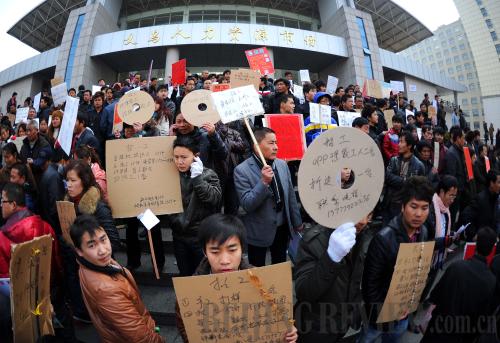|
 |
|
ALLURE OF EMPLOYMENT: Companies post job applications at the gate of a labor market in the city of Yiwu in east China's Zhejiang Province on February 15, 2011. Local businesses have been striving to attract more workers after a labor shortage following the Spring Festival holiday (XU YU) |
For the fifth time in as many years, China is facing a shortage of manpower following the Spring Festival holiday. Several of the country's provinces are seeing fewer migrant workers returning to work after going back to their hometowns to celebrate the holiday. However, economic analyst Ye Tan believes that the labor shortage might bring about some positive changes in the way east China's manufacturing economy operates. An excerpt from her article from the National Business Daily can be found below.
A shortage of workers in China is not necessarily a bad thing. It indicates that China's industry is transforming. There is now hope for migrant workers to improve their living conditions and finally rid themselves of the poverty that was passed down from their parents.
It is normal for countries to encounter labor shortages in the midst of an industrial transformation. China has relocated medium- and low-end manufacturing industries and facilities from east China to the central and west regions, where many migrant workers come from. China's industrial transformation is essentially a result of changes, and achievements of transformation of global economic strategy. A good example is the relocation of Foxconn, a large manufacturing company that specializes in original equipment manufacture, or OEM.
Over the last couple of decades, manufacturing districts in the east have repeated a scenario in which migrant workers are employed in large numbers when the manufacturing companies have large orders coming in from abroad. When these orders shrink in size, the workers leave the region to find work elsewhere. This hiring cycle must end, or else it will ultimately wear down China's economy as a whole.
According to a recent survey by the Foreign Trade Department of Guangdong Province, 48.7 percent of manufacturing companies in the province said their export orders increased significantly in 2010, in comparison to the number of orders placed in 2009. Guangdong's exports have been actively growing in the last few months, particularly in December 2010, when its total exports came out to $39.97 billion, rising by 23.5 percent compared with the same period in 2009. What this says is that Guangdong and other manufacturing hubs in east China are back to old ways of compensation trade practiced in 1978.
Despite the fact that east China has now formed a complete industrial production chain, they have still failed to stimulate domestic demand for their products. Generations of skilled workers are not being cultivated, and China's wealth gap continues to grow. This is not necessarily the fault of these coastal manufacturing areas, but is instead the result of an inherently rigid management pattern that could spell trouble for China's economy in the future.
Developing the manufacturing industry in west China might be the best way to level regional disparities and cultivate more proficient industrial workers. Development in central and west China is designed to balance income levels and general welfare in all localities of China, so as to create a greater sense of social security and accordingly promote changes in the country's administrative systems.
However, a manufacturing economy based on OEM products is not promising. The various regions of China should not have to compete with their own labor forces and cheap resources. Rather, they should have their own name-brand products and an innovation-oriented economy. Surging exports in recent years have allowed the east coast manufacturers to create these kinds of products. But at this moment, what east China needs is more innovation, and not just bigger export orders.
The east coast will fail if it tries to compete with the west in terms of labor power and industrial resources. East China has better new ideas, bigger markets and more capital. China's economic rise as a whole will depend on the joint efforts of business people and the financial sector of east China.
Although the two regions are markedly different in a number of ways, both east and west China are now trying to make ends meet by focusing on OEM industry, causing the two regions to fight over migrant worker populations.
It is fortunate that more companies, local governments and scientific research institutions are making changes to the way they do business. They are allowing for the entry of middle- and high-end manufacturing, as well as making progress in other industries. However, there is still much work to be done. New and innovative technological concepts such as the "Internet of Things" may prove to be lucrative in the future, but as far as China goes, the concept is just that: an idea that has yet to bear fruit.
One day, when high-end brands manufactured in east China are recognized by the domestic and global markets, companies in east China may finally ease their grip on the country's migrant worker population, and instead focus on innovating and creating.
In other words, this new labor shortage might just be a sign of things to come – a signal that might mean a higher quality of life for one of the most important segments of China's population. | 